In this conversation the acclaimed production designer Sarah Greenwood talks about her craft, the research work that goes into the preparation stage of a new production, why every production is a period one, the famous Dunkirk beach scene in “Atonement”, her take on the advancement of digital tools, and “Anna Karenina” which is her latest collaboration with director Joe Wright, set decorator Katie Spencer and actors Jude Law and Keira Knightley.
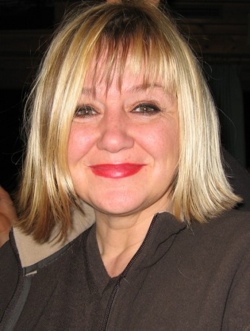 Kirill: Tell us about how it all started for you…
Kirill: Tell us about how it all started for you…
Sarah: I trained as a theater designer at the Wimbledon School of Arts, and I worked in theater for three years. I found it enjoyable, but it was strangely unsatisfying. There was something collaborative that was missing. When you work on a film set, you have a very close relationship with the director, and I certainly wasn’t finding that in the work I was doing in the theater. It also involved traveling a lot around the UK, and I quite liked being based in London, see my friends and earn proper money. So I sold my soul to the devil and started working at the BBC which actually was fantastic.
At that time BBC had a massive art department, and it was an amazing training ground. So making the transformation from theater to film television was helped by the training we got there and the work that we did. Working for the BBC was fantastic. You could go two routes – assistant art director or set designing on small productions. I went down the second route, and started designing moving quickly onto “Later with Jools Holland”. I moved into the drama department working with some fantastic directors like Patrick Marbur on “After Miss Julie” and with Mike Barker on “The Tenant of Wildfell Hall”. And then with demise the design department at the BBC in the mid 1990’ss, I joined the freelance world and started working in film.
That was the story of my transition from theater to television to film. I went backwards and forwards for a bit, and decided that I much prefer film. I’m much more suited to film design. I have friends who still work in theater, and I could never design as well as that. My design work in much more suited to film, and I’m happy to working in this medium.
Kirill: Do you see yourself going back to more restrained budgets of television productions?
Sarah: I would like to say yes creatively, but financially probably not. The budgets were tight then and it was fine because you were going through them, but I would probably struggle a bit now with the scale of the budgets. But why not? Although going back to Theatre is a step to far, Joe Wright [director] just has come back to theater and wanted me to do it with him – two shows next year. I’ve chosen not to because conceptually that is so different. As much as theater design informs film design, being character-based and script-led, I think aesthetically they are so different now for me to go back and design theater.
But to go back to television – as they say, never say never. There’s some brilliant television that’s done, particularly at the BBC. They do amazing things, but at the moment it’s probably not for me.
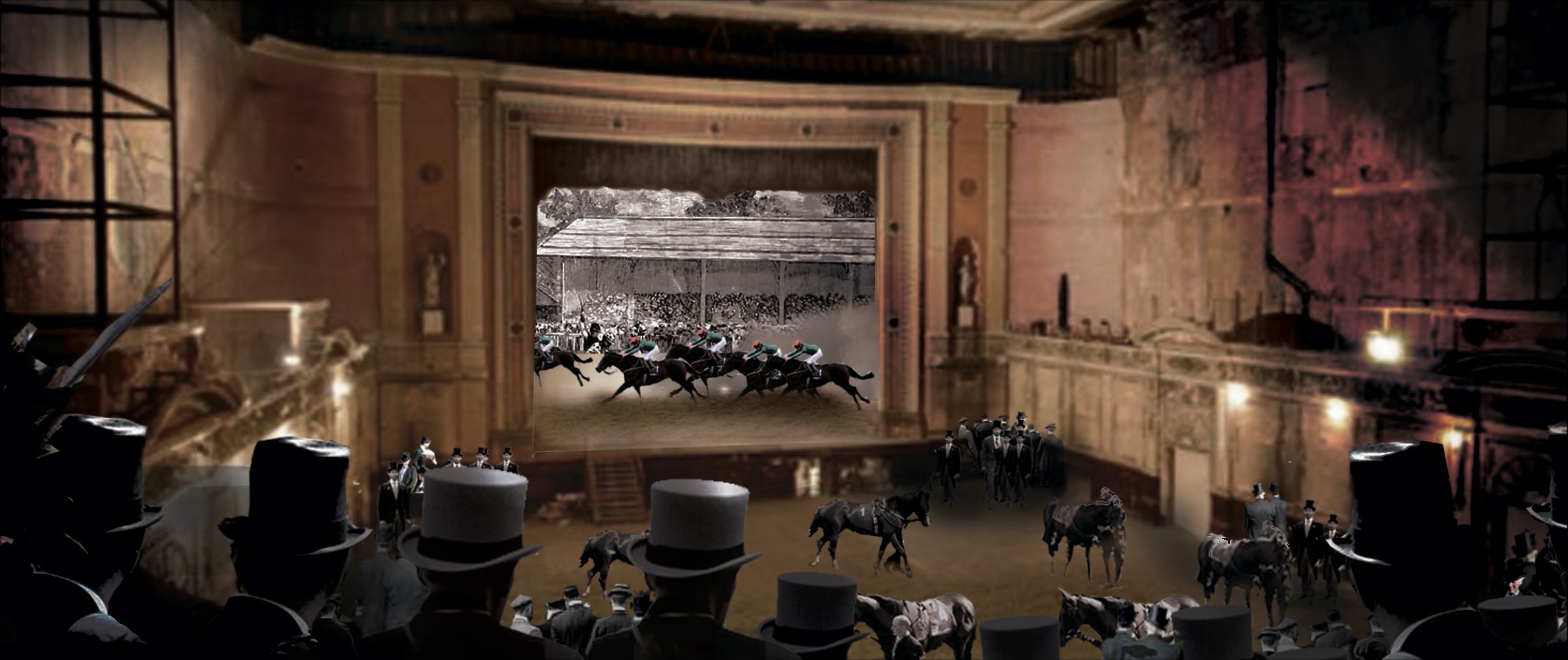
Set sketch for “Anna Karenina”, courtesy of Sarah Greenwood.
Kirill: Do you think that you’ve been “spoiled” by the much bigger budgets of your recent films?
Sarah: The bottom line is that there’s never enough money, no matter what your budget is or your scale. You never have enough time or enough money, which is fine,its the way. You can go from “Sherlock” which had a budget of $130M to “Anna Karenina” which had a budget of $25M, and they’re both equally short on time. There are compromises in both but, creatively good things often come out of those challenges that. If you tell me to go back to a television production with a budget of $2.5M, I’m sure I could do it, but that’s not the route that I’m going down at the moment. Equally, maybe in the future when I don’t want to be working away or stressing as much as the big productions demand I might want to change direction.
Continue reading »
Our daily job as programmers is to solve problems. Some view this as a just a job with a steady paycheck, rarely venturing outside the daily routine, not interested in learning new techniques or pushing their own boundaries. Some enjoy working on side projects, exploring new languages or just reading blogs to stay current. Hopefully, as the years pass, you grow and enrich your own personal arsenal of tips, tricks, techniques and ways to assess and solve problems. Finding the best solution to the specific problem at hand within the constraints of available time and specific programming environment.
Simple problems should have simple solutions. That’s kind of obvious. Except when people insist on creating artificial complexity while solving them, either out of lack of knowledge or out of fear that if simple solutions is all they have, they will fail to uphold their seniority status. And so you end up with people writing their own string replacement routines instead of using regular expressions, writing their own persistence layers with opaque binary blobs that serialize multi-field multi-level object hierarchies instead of using databases, or inventing WSDL and UML.
Complex problems can have simple solutions as well. At times, we tend to forget the underlying math complexity behind such elegant data structures as hash tables and balanced trees, the ingenuity behind bloom filters, Perlin noise generators and inverse square root approximation, or the sheer power of recursion that gives us such beauty as Quicksort. Once these are tucked safely behind library APIs – provided by either the runtime itself or written as a utility layer in your own project – they become just a few more entries in your toolbox, and you rarely spend time to appreciate their powerful elegance.
And then there are complex problems for which we don’t seem yet to have simple solutions. Sometimes you need to combine a few tools that you have, and sometimes you need to sit down and create a brand new complex solution. That’s what we’re paid for, after all. And then, sometimes, there is an existing solution. And it feels just the right fit for this problem we’re trying to solve.
Such is the case of using vector image formats for scalable graphics, which is most often boiled down to using – or at least trying to use – SVG for icons on platforms that run on a wide variety of screen pixel densities. On one hand, you have a problem of scaling your graphics on screens of various sizes and resolutions. On the other hand, you have a solution that claims to do just that. And it feels that these two are a perfect match.
And you can start by thinking that it’s a simple problem of scaling the entire icon up or down, and that it’s a simple solution of taking one of the existing SVG libraries and asking your designers to export all their assets in that format. And if your designers know what they’re doing, they’ll come back to say that they don’t want to just scale everything. They want to hide some visuals for smaller point sizes, tweak proportions as the target point size changes, or even switch to a different overall composition beyond a certain threshold. And while for you it’s all pixels, for them it’s points. And then you need to understand what’s the difference. And then you may realize that it’s no longer a simple problem, but you don’t want to throw away that nice simple solution. So you go read a bit more about the SVG format, and it’s this gigantic spec that supports embedded bitmaps, embedded fonts, animations and even interactivity layer that can run scripts on user interaction. And it’s no longer a simple solution. It’s this complex solution. And its complexity scope seems to match the new complexity scope of the problem.
And so now you have a complex problem and an existing complex solution. And it feels like they are a good match. If only you can just find the right subset of functionality and the right set of tools that will allow your designer to create those custom elements in the exported files. And with every objection your designer raises, you only are more determined to dig into the format spec and find a section that seems to be a good match. And as you dig deeper and deeper, the feeling that you have a good match becomes a firm conviction. And you never look back at the complexity you have built trying to match the “almost there, but not quite” solution to this problem. It was never “almost there”, mind you. But it takes time to actually realize that. And then SVG becomes another entry in your arsenal of tools. A tool that is not great – or even decent – at solving the problems that it claims to solve. Not yet. Not this year. Maybe the next one.
Khoi Vinh on the limited edition of Herb Lubalin monograph from Unit Editions in his “Are Design Books Meant to be Read“:
Inside, pure gorgeousness awaits. Page after page of exquisite photographs of original Lubalin works to pore over, extensively captioned by Shaughnessy. There’s also a copious biography of Lubalin’s life and career, roughly seventy-five pages of well-illustrated narrative and analysis that I’m genuinely interested in reading.
But, I’ll probably never read it. The book weighs something like five pounds or more, so I’ll never carry it with me, and reading on the go is how I do the vast majority of my reading. If I’m honest with myself too, the same goes for the other books I’ve bought from Unit Editions — they all sit on my shelf, basically unread and very rarely touched.
“Never” is a strong word. Having said that, I probably am never going to buy another printed copy of a fiction novel. I don’t know for how long I’ll have access to my current collection of digital books. It would seem that digital bookshops have been with us forever, but really IBM is the only computer company that survived more than two human generations. How likely is it that the current digital media hubs (say, Amazon, Apple, Google, B&N, Netflix) will be with us when I’m retired?
A physical book perishes. It gathers dust, the paper crumbles, bugs eat it, water warps it and fire destroys it completely. A digital book perishes differently. Somewhere out “in the cloud” there is some database that stores pairs of bookId–userId associations. That database is probably backed up and replicated like crazy. But bugs happen. And companies disappear. If the customers are lucky, they’ll be able to extract their data before the cloud services are no longer available. Formats get deprecated, and custom software emulators / hardware that can display data in old formats get more expensive. We don’t see, because it happened so damn recently, and we just didn’t yet have a chance to see one of the behemoths implode.
Library of Alexandria has seen its 40,000 books perished in fire, never to be passed on to future generations. Us. Imagine a solar flare so powerful that it knocks off all electronic equipment on Earth. Ironically, printed copies would be the way to restore the lost digital copies. For those books that had physical copies to begin with.
And some books are best consumed in their physical form. The texture of the hard cover. The smell of the paper. Color illustrations fading away and losing some of the pigment to the opposite page. A medium that does not have a notification bar, or a mobile connection. A medium that makes it a mental effort to remember the last page you read. A medium that does not have word highlight or search, and requires a concerted effort to flip back to find and re-read that passage that you particularly liked. A medium that does not allow to quickly share it on your favorite social network with a couple of clicks.
Design books that are meant to be read. Words, sentences, stories. Beautifully formatted and perfectly suited to be read in a printed book. Still.
In this conversation Judy Rhee talks about the craft of production design and art direction, taking a look at her work on commercials, TV productions and feature films. After discussing the similarities and differences in scope and pace for the various productions, she talks about her work on “My Blueberry Nights”, a romantic drama that takes Norah Jones on a journey across America. I’ll just go til I run out of places to go, and her path takes her from New York to Tennessee to Nevada and back. Explosively colorful, and yet never flashy, the film is a veritable cinematic feast, and Judy talks about how this production was unlike any other she has worked on so far.
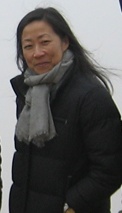 Kirill: You’ve been doing a lot of things in movies, TV and commercials. How did it all start?
Kirill: You’ve been doing a lot of things in movies, TV and commercials. How did it all start?
Judy: I went to film school and became interested in production design through watching films and taking a cinema studies class in the history of art direction. At the time they didn’t have any production design/art direction classes at NYU in the film department. They only had a Theater/Stage Design in the theater department, but as a film student you weren’t allowed to take classes in theater design unless you were a theater design major, so I ended-up taking related classes at Pratt Institute and SVA [School of Visual Arts].
While watching and critiquing films in classes, I found it puzzling how a lot of the films we’re just focusing on the camera work (i.e. renting helicopters and Steadicams), but no one was paying any attention to the environment they were shooting in – a lot of actors against white walls. I became interested in exploring how you can help tell the story visually by just making a few changes to the set(s) or locations. I offered my services to other students and started working on their student films to make their stories more interesting and compelling by modifying, adding or embellishing their film environments and sets.
I was bar-tending and waitressing while attending NYU and 1-day one of my regular customers, who worked at the Metropolitan Opera doing make-up, came in and said he was working on a horror film called “Frankenhooker”, and he said they we’re replacing the art department that day and I should go down there if I was interested in working in the Art Department. I went there and was hired as an art intern, doing everything from driving the van doing pickups/drop-offs, making and painting props, helping with shopping and set-dressing. It was a non-union film, so everyone did a little bit of everything. It was a lot of work and a lot of fun – a great learning experience!
After that film wrapped I was hired full-time in the art department for his second film, “Basket Case 2” dir. Frank Henenlotter. He did a lot of B-rated horror films. I wouldn’t mind working on a another horror film. From that point on it was just word of mouth, and I just continued to work steadily.
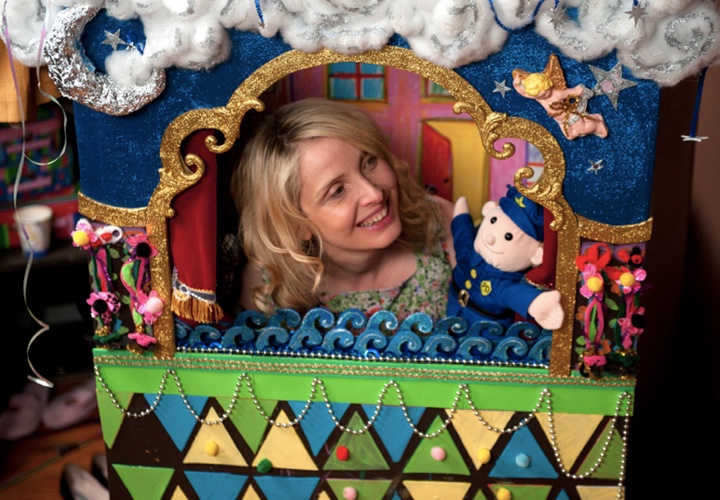
Opening scene of “2 Days in New York”, Julie Delpy in her child’s puppet theater, courtesy of Judy Rhee.
Cut to 20+ years later, I’m still working on films and commercials. Sometimes I travel or re-locate for work. I went to Jordan to work on a film, “Stoning of Soraya M.” for 4 months, which was really an interesting experience for me. I worked in Atlanta on Tyler Perry‘s TV series “Meet the Browns” for 2 seasons. For that TV show I was able to utilize my background in commercials and movies because the pace of it was like doing a small film on a commercial schedule. Sometimes we would get a script on Tuesday, design a set on Wednesday, start building on Thursday, paint on Friday, set-dress it on Saturday and then shoot it on Monday. Even for TV, it’s a very fast turnaround. My experience and knowledge in working on commercials where everything happens very quickly allowed me to deliver what was expected in an abbreviated timeline.
You still have to design these sets with narrative in mind of what the story is, who are these characters, what are we trying to convey visually – even if it’s a sitcom. My job is to support the director to help tell the story.
I currently have a film out now in theaters, “2 days in New York”, written, directed and starring July Delpy and Chris Rock. It’s a sequel to “2 Days In Paris”.
I just finished another comedy in NY called “My Man Is a Loser”. It was a very quick 24-day shoot. Written and directed by Mike Young, starring Michael Rappaport, Sean Young, John Stamos and Bryan Callen. It’s a first feature film for Mike Young, and he was one of the writers on “Entourage”. It went really well, I think it will be a funny movie. The current scheduled release is spring 2013.
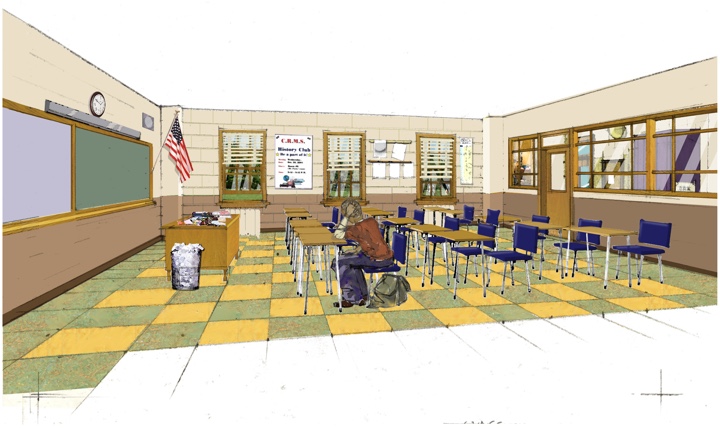
Classroom set rendering for season 3 of “Meet the Browns”, courtesy of Judy Rhee.
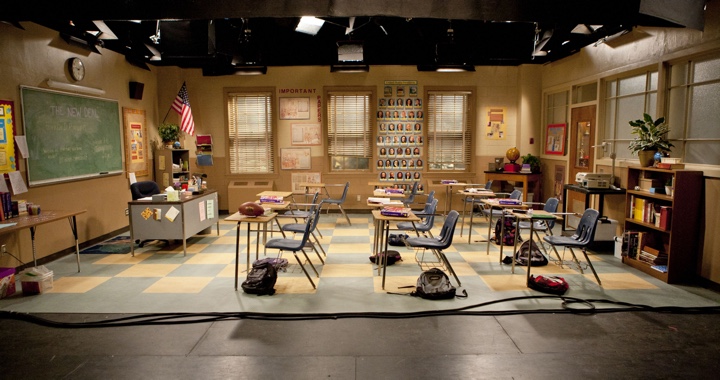
Classroom final set for season 3 of “Meet the Browns”, courtesy of Judy Rhee.
Kirill: Do you like moving between different types and scales of productions?
Judy: Every project is different and there are always new challenges, regardless of the size and scale. The process is different from commercials to TV studio shows to films. I can’t say that I prefer one over the other. I like them all because it engages different parts of my brain and there’s always something new, whether it’s time constraints, financial challenges or different and specific expectations. The end products are different. If I can generalize; on a commercial the details of props and set-dressing can sometimes be more important and very specific to the product you’re selling, who the director is and what the expectations are from the Ad Agency and Clients. For Film and TV, the details are sometimes less important – it’s more about the broad strokes of story and characters, obviously depending on the director. That’s not to say there isn’t a narrative you’re trying to create in 30-second spot, you just have to convey it in less time, hence the importance of the specific prop(s) and/or set-dressing.
Continue reading »
![]() Kirill: Tell us about how it all started for you…
Kirill: Tell us about how it all started for you…![]()